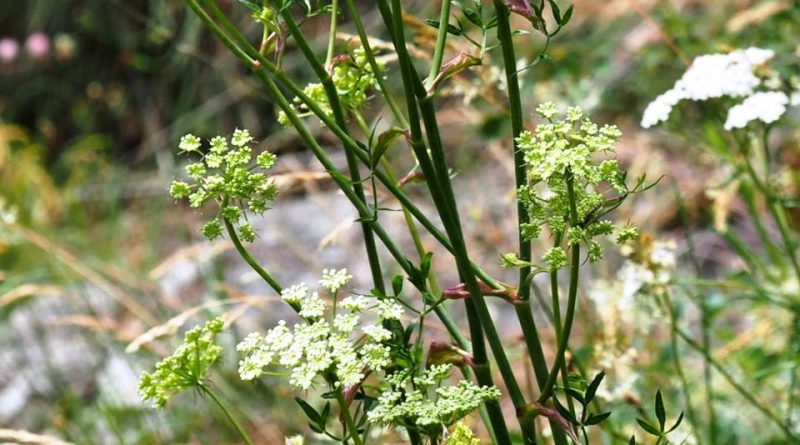Oreoselinum nigrum
Oreoselinum nigrum
The mountain parsley (Oreoselinum nigrum Delarbre) is a herbaceous species belonging to the Apiaceae family.
Systematics –
From a systematic point of view it belongs to:
Eukaryota Domain,
Kingdom Plantae,
Magnoliophyta Division,
Magnoliopsida class,
Order Apiales,
Apiaceae family,
Genus Oreoselinum,
Species O. nigrum.
The terms are synonymous:
– Peucedanum oreoselinum (L.) Munch .;
– Athamanta oreoselinum L ..
Etymology –
The term Oreoselinum comes from the Greek prefix ὀρεο- oreo- relating to the mountains, derived from ὄρος óros monte, and from Selinum (see): Selinum di monte.
The specific epithet nigrum comes from black niger: due to the color of the seeds.
Geographic Distribution and Habitat –
The mountain parsley is a species with a European-Caucasian distribution and present in all regions of continental Italy.
Its habitat is that of the edges of thermophilic deciduous broad-leaved woods and subarid meadows, on fairly deep clayey soils, usually calcareous but sometimes decalcified and therefore with a subacid or neutral reaction; it is present from sea level up to about 1200 m.
Description –
Oreoselinum nigrum is a perennial herbaceous plant, with a scent of parsley, hairless and green, which grows between 30 and 60 cm.
It has a vertical or oblique tap root, with white pulp and blackish sheaths.
The stem is erect, full and solid, streaked, often reddish, with little branching in the upper half.
The leaves are identical green on both sides, with long spread and supple petioles, which join the stem with a thick sheath; the lower ones have an ovate triangular outline, 2-3 feathers seven with primary division at right angles to the rachis, and last pinnate-parted or ovate-triangular segments, with 3-5 lobes, slightly mucronate triangular lamina and at least twice the length of the petiole; the leaves of the caule smaller, triangular, 2-3 pinnatosette.
The inflorescence is an umbel of umbels with 15-30 equal or slightly different rays, slightly widened at the base, casing with ten linear-lanceolate, reflected, herbaceous bracts and bracts. The umbrellas are with 15-30 actinomorphic flowers, small-sized dialipetals, with five elements; calyx with small greenish triangular teeth; white petals with a suborbicular outline, fringed, folded; wide and conical stilopodium; styles diverging and sharply narrowed in the apical part, longer than the stilopodium; bicarpellar inferior ovary.
The fruit, suborbicular, fringed at the top, is a polachenarian, schizocarp of 4.2-8 x 4-7 mm, which is divided into two dark reddish-brown mericarps, with three slightly marked ribs and 04-1 wings , 4 mm, whitish.
Cultivation –
Oreoselinum nigrum is a plant that is harvested in its natural state for local use as a medicine and source of materials.
It is an easy to grow plant that grows in any soil that retains moisture in a sunny location and is suitable for group plantings in a natural garden.
Propagation occurs by seed which must be sown in early spring either in the open field or in seedbeds and with transplanting as soon as the seedlings can be handled.
Customs and Traditions –
Oreoselinum nigrum is a plant that although no mention of toxicity has been found, skin contact with the sap of a number of plants of this genus is said to cause photosensitivity and / or dermatitis in some people.
According to some reports it seems that it contains myristicin which, due to its neurotoxic characteristics, make it an anti-nutritional substance.
There are no reports on the food use of this species.
The plant produces an essential oil.
This plant has been attributed antipyretic, diuretic, sweat, febrifugal, antiscorbutic, emmenagogic and stimulating properties.
However, given the lack of information, its use is not recommended.
Preparation Method –
According to ancient traditions and local customs, the root of the Oreoselinum nigrum is used for the alleged properties described above.
Guido Bissanti
Sources
– Acta Plantarum – Flora of the Italian Regions.
– Wikipedia, the free encyclopedia.
– Useful Tropical Plants Database.
– Conti F., Abbate G., Alessandrini A., Blasi C. (ed.), 2005. An annotated checklist of the Italian vascular flora, Palombi Editore.
– Pignatti S., 1982. Flora of Italy, Edagricole, Bologna.
– Treben M., 2000. Health from the Lord’s Pharmacy, Advice and experiences with medicinal herbs, Ennsthaler Editore.
Warning: Pharmaceutical applications and alimurgical uses are indicated for informational purposes only, they do not represent in any way a medical prescription; therefore no responsibility is taken for their use for curative, aesthetic or food purposes.


